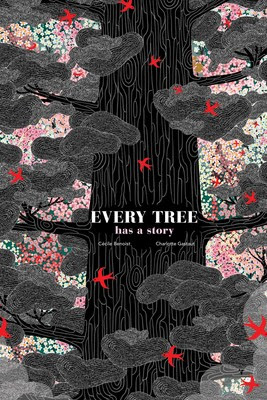By Cécile Benoist and Charlotte Gastaut
Downtown Bookworks; 2018
Originally published in France as Un arbe, une historie (A Tree, A Story), this gorgeous oversized children's book is visually quite striking. The bold artwork by Charlotte Gastaut fills each 14-inch-high, 18-inch-long two-page spread with elaborately constructed imagery, dense with design elements and filigree. There is space left on each for the text of the story being illustrated, of course, but writer Cécile Benoist's paragraphs of prose always look secondary...as is wholly appropriate in a picture book.
Which isn't to say those words are without value, of course, just that they can look barely-there embedded as they are with often arresting images. They are, of course, integral, as they explain what exactly we're looking at, the story of which isn't always clear just by the imagery.
There are just over a dozen stories told within, and thee are occasionally broken up with pages devoted to listing special trees of tree-related facts.
The stories run a rather wide gamut, but among them are simplified and straightforward versions of those featuring well-known tree heroes like Kenya's Wangari Maathai and her Green Belt Movement and America's Julia Butterfly Hill and her two years spent living in Luna. There are also stories of artists like Sam Van Aken, who created a tree of 40 fruits through grafting, and photographer Michael Nichols, who photographed the gigantic President Tree in California's Sequoia National Park. And there are stories that barely have people in them at all, like that of The Great Banyan Tree in Calcutta, India and the Ténéré Tree that was for a long time the only living thing for hundreds of miles in the Ténéré Desert in Niger.
Though the art is quite sophisticated, the book seems to be aimed toward younger readers, as no stories exceeds a half-dozen paragraphs in a corner of a two-page spread, and Benoist pauses to define words and terms like botanist, dowry, canopy, graft and reforesting the land. At least two of the stories have tough subject matter that might prove a bit challenging for some younger readers, though, like "The Golden Spruce and The Lumberjack", which involves crime, death and suggestions of mental illness, and "Eucalyptus Apocalypse", which tells of the clearcutting of Tasmanian forests in the 1970s, illustrated by a picture in which the vaguely airplane-shaped birds that flit through most pages of Gastaut's art are drawn flying while aflame, looks of concern on their simplified faces.
Gastaut uses a quite limited palette in each of her images, generally just three or four colors beyond that black and white that most of the trees and people are rendered in. It's hard to accurately describe the art—and you're really better off just seeking the book out for yourself than listening to me try to do so—but the coloring as well as the rendering are highly stylized and quite distant from the natural browns and greens and organic messiness one might associate with the natural world (By the way, you can see a handful of stories from the book here). Each page is beautiful, but beautiful in an entirely different way than the subject matter as it exits in the real world is beautiful.
An all-ages book in the best sense of the word, Every Tree Has a Story has as much to offer adults (be it the aesthetic pleasures of the artwork, or suggestions for people and trees to learn more about) as it does the children it was apparently made for.

No comments:
Post a Comment